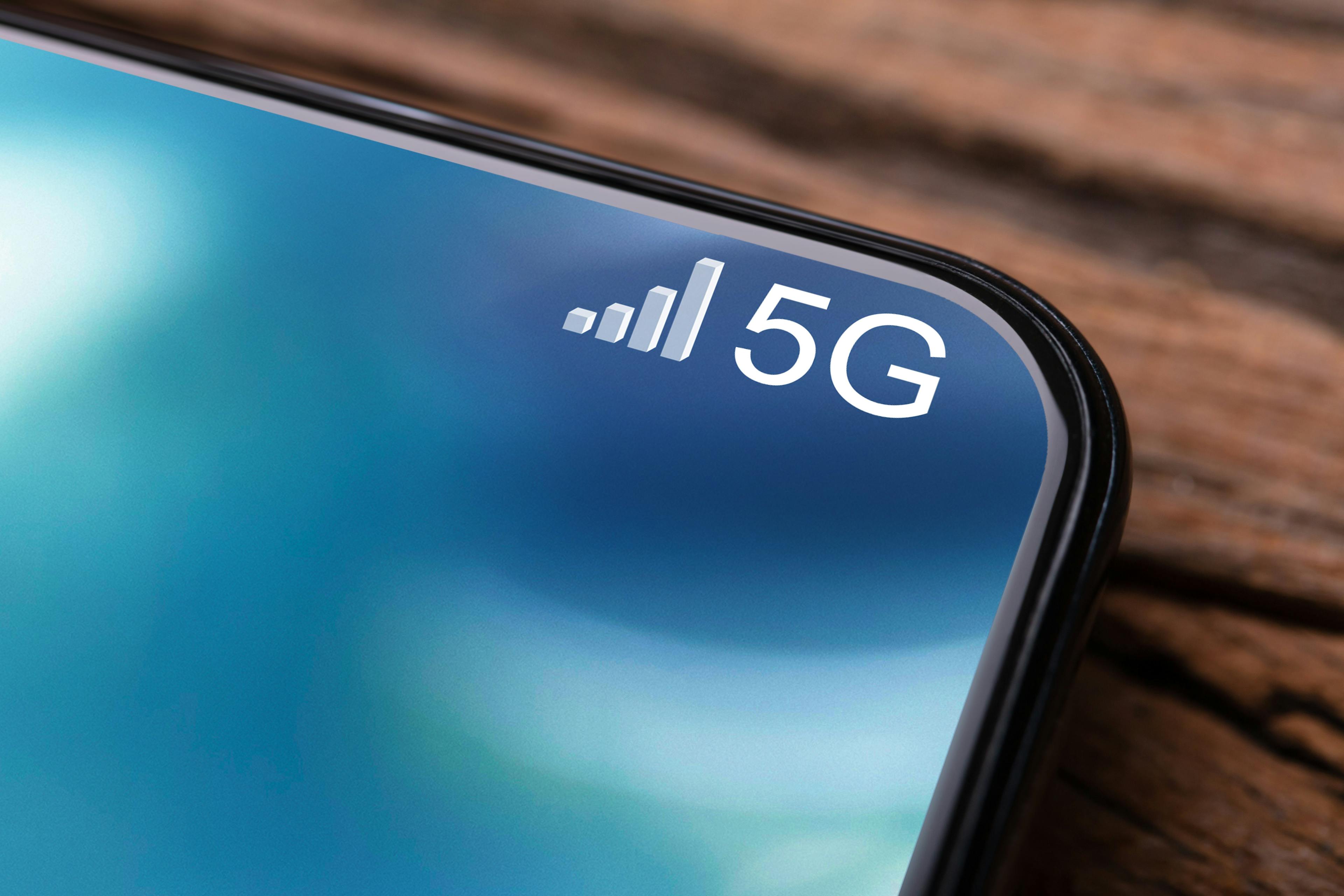Home


Resource Center
The rollout of the 5G network has offered the world the promise of a game-changing experience, whether through the personalized benefits of consumer devices or the professional benefits to company operations.
When it comes to implementation of 5G in business, both of these impacts work together to provide significant benefits to business owners. Understanding the 5G network is the first step to recognizing its full potential.

What Is 5G?
5G is the latest cellular network update that offers users increased speed and bandwidth. The benefits of 5G include a faster transfer rate, less latency, and higher bandwidth capabilities.
So how fast is 5G? Rather than the 150 MBps download and 15 MBps upload speeds of 4G, 5G offers transfer rates of 20 GBps and 10 GBps. This means transfers happen almost 100 times faster with 5G — virtually eliminating the wait time we experience now. Latency is also improved over 5G’s predecessor, going from 30 milliseconds to around 1 millisecond, making 5G almost instantaneous. Finally, 5G was created to support a much heavier device load. Increased bandwidth allows 1,000 more users per meter to interact with the same tower without experiencing delays in data transfer.
How Does 5G Work?
The 4G network was created using radio frequencies below 6 GHz, while 5G is based on 30 GHz or more. The higher frequencies allow a much greater capacity for transferring data at faster rates. The directional quality of these frequencies also means less interference with other wireless signals compared to 4G, which spreads data in multiple directions.
5G also uses shorter wavelengths — condensing the towers needed for 4G into significantly smaller units and allowing for more precise control. A single base station can support multiple antennas, meaning that 5G gives carriers the ability to support more than 1,000 more devices than they are currently able to by using 4G. Cellular repeater systems can improve the signal even further. All these changes translate into a definitively improved experience for users.
Now that we have a general understanding of what 5G can do, here are five ways that this enhanced technology impacts the relationship between businesses and their professional devices.
1. Improved Data Security
The security risks of cellular communication have long been a major concern for businesses as data breaches continue to dominate headlines. The nature of these networks offers a variety of vulnerabilities for hackers to target. Though previous generations have had adequate security measures in place, 5G creates a platform that greatly increases the potential for a more secure experience. The network itself offers a variety of improvements that pave the way for more secure data, such as:
- IoT management
- Improved transport security
- Better privacy
- Greater security in base station identification
- New security standards for the cloud and IP
- Updated isolated architecture for end-to-end service
Beyond these features, the 5G operations are based on the National Institute of Standards and Technology’s Cybersecurity Framework. This creates a network that can be better supervised and offers a more trustworthy user experience. For companies, this provides an opportunity to develop systems that work with the 5G network to increase the security of sensitive data and communications.
Though the use of 5G does not immediately offer solutions to security weaknesses, the potential is clear for significant improvement. Businesses that offer a higher level of security for consumer data have an advantage over competitors, and a more secure network reduces the risk of hackers exposing critical in-house communications.
2. Enhanced Automation and AI Capabilities
One of the better-known benefits of 5G is the increased speed with which data can be transferred. This lowered latency creates an opportunity to further technological advances involving automation and artificial intelligence (AI).
For AI, faster networks allow programs to adjust in real time, creating a user experience that is more realistic and offers more practical applications. When it comes to automation, companies can anticipate controlling their automated warehouses and production lines from simple mobile devices — adjusting in the moment as needed.
For example:
- Identify trends. Real-time AI analysis of consumer demand for a product can identify trends more accurately, allowing businesses to scale their automated production operations up or down as needed, which reduces wasted materials and storage costs.
- Automate social media. AI programs can be used to automate professional social media accounts, rapidly learning the needs and wants of consumers who interact with the business online. Responses to engagement are tailored to match the tone and speech preferences of the conversation to encourage a more positive experience for the consumer, while AI analysis of social approval ensures a much lower chance of offending the user.
- Improve operations. Employees who work in multiple locations can use AI to improve the experience using their professional devices. These devices can adjust accessibility to tools and applications needed for common tasks based on the location, time, or other relevant parameters. They can also give marketing teams an edge by developing intelligent strategies that match current industry trends and better anticipate consumer needs.
3. Support for IoT
The Internet of Things (IoT) offers a wealth of data for businesses to use when trying to improve the customer experience, meet new demands with their products and increase efficiency in their operations. With the introduction of 5G, the information from IoT has the potential to increase significantly. Since 5G towers can host a greater number of devices without negatively impacting transfer speeds, the use of internet-capable devices is much more convenient for consumers and businesses than ever before — allowing for even greater connectivity.
This increase in connected devices will help businesses better understand the behaviors of their customers and give greater insight into the needs of their employees. As companies increase the use of internet-capable professional devices, they will have the ability to see how staff use these devices, giving them an opportunity to tailor their equipment, software, and apps to support their needs.
4. Increased Cloud Connectivity
The transition to 5G also provides companies with a more efficient connection to the cloud, bringing edge computing to the forefront. Edge computing relies on transferring information on the edge of the network rather than through its core. Due to the increased bandwidth and speeds allowed through 5G, edge computing becomes crucial in the transfer of increased data from the IoT at much higher speeds than previously possible. This opens doors for more meaningful cloud-based technology that isn’t limited by the speed and scope of previous network generations.
5. Improved Employee Experience
The implementation of 5G in the workplace results in a much quicker data transfer experience, opening doors for better communication between staff members. Internal communications can be received in a fraction of the time required for previous network generations with fewer glitches, potentially eliminating buffering and connection issues when communicating through video meeting programs. Better real-time communication prevents disruption of the free flow of ideas between parties and creates a more natural experience that better mimics face-to-face meetings.
The incorporation of AI on professional devices automates many of the simple daily tasks that are necessary for operations but take up valuable work hours throughout the year. By creating processes that allow tedious busywork to be completed with minimal oversight on remote devices, your business can save valuable time that would be better spent serving company needs that require human elements, such as innovation and consumer relations.
The consumer information that can be gathered through the IoT will give greater insight into customer needs, allowing employees to make informed decisions based on real information rather than necessitating the kind of guesswork that could result in a poor user experience. Employees who are given tools to improve their performance and are set up for success experience greater job satisfaction and a more comfortable sense of professional responsibility.
Finally, 5G offers an opportunity to expand the use of cloud connectivity. Cloud-based applications can increase in complexity without sacrificing usability on employee devices. This opens doors for employees to have access to programs while working in the field that currently require increased processing power or a stronger connection. Rather than gathering information and returning to the office to enter and assess their data, these processes can be completed in real time and on location, providing results that translate into immediate actions.
Together, these improvements provide businesses with happier and more satisfied employees, increased efficiency in systems and less wasted company time — giving your company a competitive edge.
When Will 5G Be Available?
The rollout for 5G has already begun, with some carriers starting implementation in 2019. Towers are being placed in strategic areas; companies in large cities are likelier to find they already have access, while those in smaller towns may still be waiting.
If you wish to explore 5G network benefits for your company, start by contacting WilsonPro. We provide a range of 5G repeater systems for low-band, mid-band, and high-band cellular coverage.

